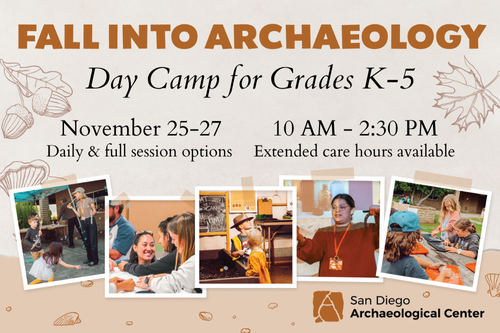San Diego Archaeological Center
Fall Into Archaeology Day Camp
San Diego Archaeological Center 16666 San Pasqual Valley Road, Escondido, CA, United StatesWe are excited to announce our brand-new autumn day camp for elementary school students! This a la carte style day camp will take place the week of Thanksgiving. Choose individual days or choose them all! Whether your child or grandchild is a budding archaeologist or just eager to experience the past in a whole new way, our camp offers something for everyone. Get ready for a week filled with adventure, discovery, and endless fun! Space is limited to 30 campers per session. Sign up now and let the adventure begin! Grades: K-5 Schedule: Monday, November 25: Archaeology and the Ancient World – Come discover what archaeology is, is not, and what is bad archaeology. Explore the museum, get a behind-the-scenes tour of our collections laboratory, make coil pots, and practice your beadmaking skills. Tuesday, November 26: Ancient Games Day – Discover a world before video games, as we explore the 5,000-year-old Game of Twenty Squares, and learn to make your own ancient Egyptian Senet board. Learn to play mancala, backgammon, and chess, or try your hand at Apal Uumarr, or the game of stones. Wednesday, November 27: Ice Age Extravaganza! – Enjoy our final camp day making your very own ice age rock art. Learn cordage weaving, and basket making, and hone your atlatl throwing and archery skills. See our Archaeology Camp Page for more information.
Beadmaking, Cordage, and Basketry Workshop for Girl Scouts
San Diego Archaeological Center 16666 San Pasqual Valley Road, Escondido, CA, United StatesJoin us at the San Diego Archaeological Center for a beadmaking, cordage, and basketry workshop. Register now to save your spot. Program is $15 per scout, pay at door.
Sip & Sketch Holiday Art Class – CANCELED
San Diego Archaeological Center 16666 San Pasqual Valley Road, Escondido, CA, United StatesThis event has been CANCELED - Sip, sketch, and color at our holiday art class with archaeological illustrator Donna Walker. Learn how to draw the native plant Toyon Berry, also known as California Holly, then color your drawing with Prismacolor, an oil-based color pencil that blends and looks like a watercolor painting when you’ve finished. You’ll learn techniques that will give your objects depth and definition – gone will be the flat-looking images, yours will look 3-D! Then turn your drawing into a personalized holiday card for friends and family! All art supplies will be provided. Tickets include drinks (alcoholic and non-alcoholic options available) and light refreshments. This event is 21+. Cost: $35; SDAC Members $30
Ancient Echoes: Ice Age Pigments – Handprint Edition
San Diego Archaeological Center 16666 San Pasqual Valley Road, Escondido, CA, United StatesHave you already taken Pints & Pigments*? Ready to step up your Pleistocene rock art skills to the next level? Put on your dirty painting clothes and come to the SDAC for this all-ages outdoor art event where we’ll be spraying, blowing, and flinging our favorite ancient pigments like an Ice Age Jackson Pollock! All art materials will be provided. Tickets include coffee, tea, and light refreshments. Note: Child tickets do not include the use of traditional pigments (modern acrylic paint will be used instead). *Prior participation in our Pints & Pigments workshop is not required. About Ancient Echoes In our Ancient Echoes series, we look back into the archaeological record at the origins of many of our favorite things and breaking the conceptions of their modernity. Have you ever wondered about the roots of mead, chocolate, or beer? What about the importance of art, dance, and music to Ice Age hunter-gatherers? Ancient Echoes explores these topics and more, offering an interactive experience aimed at connecting us back with our deep past. Cost: $35; SDAC Members $25; Kids (12 & under) $15 Registration is closed. Limited tickets available at door.
Living Room Lecture – Beyond Bones: How Human Osteology Can Facilitate Wellbeing, Healing, and Inclusion
VirtualIn this lecture, Giselle Király will discuss the power of human osteoarchaeology, and how, with the right facilitation, it has the ability to promote wellbeing, healing and inclusion. This has been most notable in archaeological sites with military service people, but also seen on sites with people with low mental health, neurodivergence, ADHD, or autism. Giselle will look at sites ranging from Sutton Hoo to World War II, where archaeology, and specifically human remains, have changed peoples lives. Note: This lecture will contain images of human remains. This lecture will be held on Zoom. Cost: Pay what you wish Registration is closed. About the Speaker Giselle Király is a commercial fieldwork project officer and human osteoarchaeologist for PCAS Archaeology in England, conducting excavations and analysing skeletal assemblages ranging from the peaty Mesolithic to WWII plane crashes. She also collaborates with Operation Nightingale, of the Ministry of Defence, helping veterans on their path to recovery through archaeology. She has led fieldwork in Europe, Georgia, and across the UK, teaching osteology and field techniques to students, veterans, volunteers, and police forces. She can be seen on History Hit TV, Digging for Britain, and most notably, the revived Time Team.
Historic Archery Day
San Diego Archaeological Center 16666 San Pasqual Valley Road, Escondido, CA, United StatesWe're stringing our bows for a spot of archery right here at the San Diego Archaeological Center! Shoot some rounds and learn about how different cultures around the world crafted, hunted, and fought with bows and arrows. Register now to save your spot. This event is family friendly. Kids will enjoy a supervised range at the front of the museum all to themselves, with an adults-only range for more powerful bows in the back. No previous experience required. Please bring your own gear if possible. A limited amount of gear will be available to borrow - first come, first served. Cost: $15; GSUSA $10; SDAC Members Free Tickets include museum admission. No registration needed for SDAC Members. Registration is closed. Please pay at door.
MUSEUM CLOSED for Private Event
San Diego Archaeological Center 16666 San Pasqual Valley Road, Escondido, CA, United States2nd Saturday Lecture Screenings
San Diego Archaeological Center 16666 San Pasqual Valley Road, Escondido, CA, United StatesJoin us every 2nd Saturday of the month for two screenings of our Living Room Lectures by archaeologists, experts, and authors. Lecture screenings start at 10:30 AM and 12:30 PM and are included with museum admission. No reservations needed. Seating is first come, first served.
Art with an Archaeologist
San Diego Archaeological Center 16666 San Pasqual Valley Road, Escondido, CA, United StatesFree admission for kids on select Saturdays! Join us for family-friendly activities in our classroom, where you can create your own art with an archaeologist, become a junior archaeologist with our miniature excavation units, and curl up with a book on our cozy reading rug. Families can also explore the museum on an Archaeology Quest and check out our Excavation Station and Field Lab. Kids 12 & under: Free; Adults: $5 (includes museum admission)
Senior Wednesdays
San Diego Archaeological Center 16666 San Pasqual Valley Road, Escondido, CA, United StatesSeniors 65+ can enjoy free admission to the Center on Wednesdays. Discover the science of archaeology through our interactive Archaeology 101 exhibit, explore the cultural periods of San Diego, and uncover the Lives and Lifestyles on Block 112: The Untold Story of San Diego’s Working Class.
Story Time with an Archaeologist
San Diego Archaeological Center 16666 San Pasqual Valley Road, Escondido, CA, United StatesJoin us on select Thursday mornings for archaeology-themed story time at the Center. Stay afterwards to explore the museum with family-friendly activities like our Archaeology Quest and Field Lab.
Flintknapping Basics: The Ancient Art of Stone Tool Making
San Diego Archaeological Center 16666 San Pasqual Valley Road, Escondido, CA, United StatesStep back in time and discover the fascinating craft of flintknapping in this hands-on class! Flintknapping is the ancient technique of shaping stone into tools through the application of controlled force, a skill that has been used by humans for hundreds of thousands of years. In this class, you'll learn the basics of flintknapping, including how to create cutting tools, points, and other useful implements by striking and shaping raw stone. Guided by an experienced instructor, you’ll gain insight into the historical and cultural significance of flint tools and understand the precision involved in the process. Whether you're a history enthusiast, a survival skills aficionado, or simply curious about ancient craftsmanship, this class offers a unique opportunity to connect with a time-honored tradition. You’ll leave with not only new skills but also a deeper appreciation for how early humans created the tools that helped shape civilization. All materials are provided, and no prior experience is necessary. Ages 12 and up. Participants under the age of 18 years old must be accompanied by an adult participant. Cost: $45; SDAC Members $35; Scouts (GSUSA & Scouting America): $25 Registration is full.






